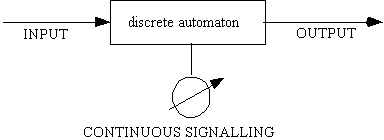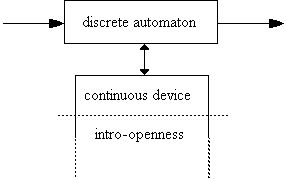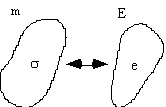Experience shows us that things do no stand
this way, we also work with the continuum. In fact we work
through a symbiosis of continuum and discontinuum. We see the
letter A with continuous shapes, but it is part of a discrete
alphabet. The letter A also bears a discrete description (as we
saw) and surely man's mind recognizes the letter A through discrete
steps. The discrete and the continuum are difficult to separate
in our everyday life, but if we analyze man's discrete machine
it is impossible not to ask for the device that realizes the continuum.
The continuum is also strengthened by the existence of our psychical
states. One interpretation could be that of a device continuously
signalling the processes taking place in the discrete automaton
(Fig. 46) i.e. without an influence upon the automaton of its continuification
properties. But we have seen that the mental-psychic, a continuous
entity, influences the human automaton and hence the attachment
of the continuous device should be done in two-way fashion (Fig. 47).

Fig. 46

Fig. 47
8. Thus we guess that behind man's
discrete automaton there is a "continuous device", and
that its participation in the automaton is necessary for its functioning
as a man. The way the continuous device participate to the automaton
is a more complicated problem, yet unsolved. The continuous device
is that which ensures the integratory activity of the brain. The
question we ask is: How much can we operate directly in the continuous
device, independent from its neuronic make up ? We can describe
the discrete automaton in the most general fashion through set
theory. An element of the set m is a state of the automaton. A
state is known by observing the physical data of all the components
making up the automaton. It is sufficient to change the physical
data of one component in order to alter the state of the automaton.
The set of states of the central nervous system is enormous but
finite, and hence there is nothing to stop the topological description
of such a set, its division into zones, the treatment of the corresponding
sub-sets, etc. But how can we characterize the integrative activity
of the brain ? What kind of mathematical elements should we use?
There are integratory states denoted by e (as
different from the machine states). But do the integratory
states form a set, say E ? If it were a set, then we would
look for the relationship between the set m and the set
E (Fig. 48). However, the degree of relative independence of
theintegrative states, especially the spiritual ones, shows us that
the state e is rather obtained through the superposition of an
integrative state (e'), in a closer connection with the machine,
and a state (e'') that does not depend directly on the
machine (Fig. 49).

Fig. 48
If E' is a set (plausible from the physical
point of view) then it is possible that to each point of the set
m we have one or more points in the set E', or a
continuumof states e'. The trajectory of our states in this continuum
canbe determined by E'' too. The change taking place
in E' due toE'' independent of the
machine can also influence a changeof state in m, thus reflecting
the reaction of the machinestates to the action of the integrative states. But
what doesE'' represent ? It could be that very special
integratory statethat attaches to e' a continuum, i.e. having a
generative power,and being in relative independence regarding the machine.
Togetherwith the machine, in a concentrated dialog, it is possible to
have a conscious creation and bring it in the machine; or it is
possible to create specific forms, adapted to the intro-openness
and transmissible in this new direction. E'' must be intro-open
with two-way access to the sources of the world. In fact E' and
E'' are informatter, and the machine m inscribes in
informatter;as seen, this inscribing takes place without breaking away from
the machine, since then consciousness and the very possibility
for creation would be lost. The separation of E into
E' and E''
is only formal, modelwise. However the question still stands unanswered
whether or not E is a set. All the states of m are
predictable,but not also the states of E which can also
succeed in our mentalfield, in relative independence, without the pace given
by theautomaton. And E, as seen, is also intro-open.

Fig. 49
Of course, the ideas presented so far are
rather general, but the present state of science does not allow
for more yet. These ideas are based on a certain philosophical
conception, based on philosophical experiments that we consider
fundamental and that were so far not yet contradicted by science.
These ideas can form the general framework for understanding
automata and man in close inter-relation.
Intro-Open Systems
81









